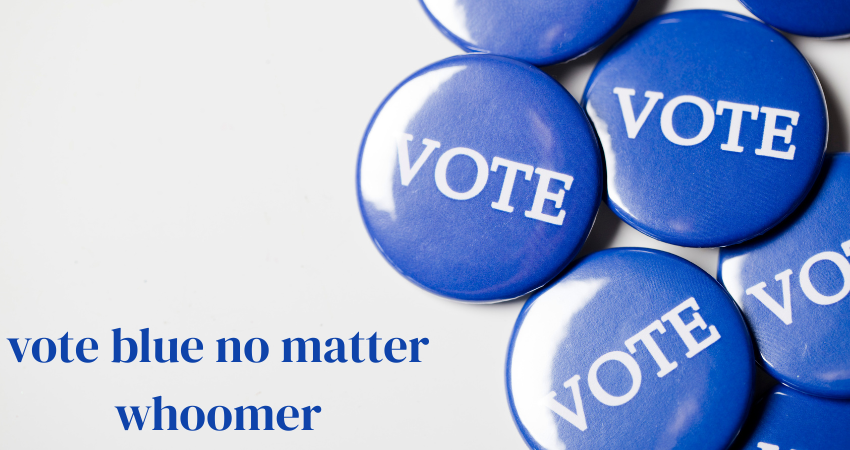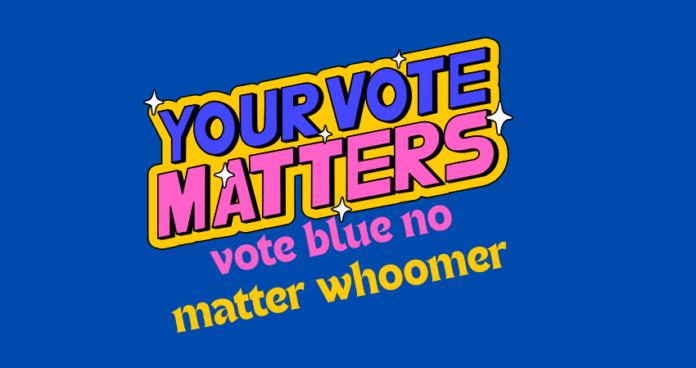At first glance, “vote blue no matter whoomer” might sound like internet nonsense, but it actually carries a lot of weight in modern political discourse. Born from the original phrase “Vote Blue No Matter Who,” this evolved slogan reflects a commitment to supporting Democratic candidates in elections, no matter their flaws, quirks, or even memes attached to them. The playful addition of “Whoomer” highlights the meme culture that fuels modern activism, transforming a serious political stance into something shareable, funny, and relatable.
This slogan isn’t just a statement. It’s a rallying cry: a call for unity, humor, and practicality all rolled into one. And yes, it’s built to spark conversation—even if it raises a few eyebrows.
Why this phrase matters in modern politics
In a time when social media drives narratives, catchy phrases become more than just words—they become tools. “Vote Blue No Matter Whoomer” isn’t about ignoring candidate flaws. Instead, it’s about acknowledging the reality that politics isn’t always about ideals; sometimes it’s about damage control and incremental progress.
By simplifying a complex idea into a viral meme, the slogan helps mobilize younger voters who might otherwise disengage. It turns apathy into action, humor into hope, and frustration into fuel. And that’s powerful.
The Origin of “Vote Blue No Matter Whoomer”
The evolution from “Vote Blue No Matter Who”
The original phrase “vote blue no matter whoomer” took off during the heated 2016 and 2020 election cycles in the United States. It emerged as Democrats debated whether to back the party’s chosen candidate—even if that candidate wasn’t their first pick—or risk splitting the vote and helping the Republican candidate win.
Over time, as internet humor evolved and meme culture blended with politics, “Whoomer” appeared. It added an ironic, playful twist while keeping the core message: it’s better to back the party candidate than to sit out or vote third-party.
The rise of meme culture in political activism
Memes have become digital campaign posters. They’re cheap to make, easy to share, and can go viral overnight. The addition of “Whoomer” shows how humor can disarm tension, make complex ideas digestible, and invite people who might tune out a traditional speech to pay attention—even if only for a scroll.
This shift from formal campaign ads to memes hasn’t just changed language; it’s changed who participates. Younger voters and online communities have become central to political movements, often rallying under banners built on jokes—but with very real consequences.

The Psychology Behind the Slogan
Tribalism and team politics
Humans naturally group themselves into teams. Whether it’s sports, fandoms, or politics, it feels comforting to belong. “Vote Blue No Matter Whoomer” taps into this instinct. It turns a complex choice into a simple one: team blue, always.
Critics see this as blind loyalty, but supporters argue it’s a realistic approach in a winner-take-all system. When the stakes are high, picking a side—even if imperfect—can seem safer than standing alone.
The emotional appeal to unity
Beyond logic, the slogan speaks to emotion. People want to feel they’re part of something bigger. A meme might seem silly, but it carries a message: “You’re not alone. We’re all in this together.” And in an era where politics often feels isolating or hopeless, that emotional connection can motivate real action.
It’s less about perfection and more about protection—shielding vulnerable communities from harmful policies by uniting, even when it feels messy.
The Power of Collective Voting
Why collective voting can swing elections
Elections often come down to razor-thin margins. A few thousand votes in a swing state can decide national outcomes. When groups organize under a single banner—even a meme-inspired one—they can tip the balance.
History shows this works. From Barack Obama’s youth-driven campaign to Joe Biden’s coalition of moderates and progressives, collective voting has played a decisive role in modern elections. The idea is simple: don’t let differences overshadow the shared goal of keeping the greater threat out of power.
Examples of successful collective voting strategies
-
2008: Obama’s campaign tapped into hope and youth turnout, using social media effectively.
-
2020: Despite fierce primary debates, most Democrats rallied behind Biden to defeat Trump.
-
Local elections: Cities have seen progressive candidates win through grassroots digital campaigns, where memes and social media messaging played a big part.
These examples show how unified voting—even if driven by imperfect slogans—can achieve tangible change.
Arguments from progressives and independents
Some progressives feel this slogan dismisses their push for deeper change. Why settle for incremental progress when you could demand more? Independents, meanwhile, worry that this mindset alienates voters who don’t fit neatly into party lines.
It’s a real tension: balancing the need for unity with the desire for reform. And it sparks debate about whether loyalty to a party can coexist with pushing that party to do better.
How to Be an Effective “Vote Blue No Matter Whoomer”
Understanding the local ballot beyond the headline names
It’s easy to get caught up in presidential campaigns and forget the local races that directly affect daily life. School boards, city councils, district attorneys—these roles often decide policies on education, criminal justice, and housing. A dedicated “Vote Blue No Matter Whoomer” understands that real change starts locally.
Do your homework before stepping into the voting booth. Research each candidate, even if they aren’t viral names. Use voter guides, candidate websites, or community forums. Look at their track record, their public statements, and who endorses them. When you know what’s at stake, your vote carries real weight.
Beyond candidates, learn about ballot measures. These initiatives can change local laws on taxes, policing, and social services. Skipping them leaves power in the hands of those who do vote—often older and more conservative populations. The best way to live out the “No Matter Whoomer” mindset? Show up informed, all the way down the ballot.
Engaging your community without alienating others
The power of a movement comes from spreading it, but not everyone will agree—and that’s okay. Rather than lecturing friends and family, share why the slogan matters to you personally. Use real examples: policies that help people you love, or moments where elections shifted history.
Stay patient, even when conversations get heated. Focus on shared goals, like fairness or healthcare, instead of party labels. Ask open-ended questions to keep dialogue going, not shut it down. Memes and slogans might catch attention, but real persuasion often happens offline, one conversation at a time.
Remember, it’s not about winning every debate. It’s about planting seeds, so when the time comes, more people see voting as a duty, not a chore. In the long run, respectful engagement builds stronger coalitions—and that’s where real change starts.
Using Social Media to Amplify Your Message
Memes, reels, and TikToks as political tools
Social media isn’t just selfies and food pics anymore—it’s where political movements thrive. Memes can distill complex topics into something people share in seconds. Reels and TikToks reach audiences that might never watch the news.
To be effective, mix humor with substance. Use trending formats but tie them to facts or policy wins. Share stories from people impacted by legislation, or use humor to highlight hypocrisy. The best content feels authentic, not scripted.
Think beyond your own feed. Engage with local candidates’ pages, comment on news posts, and share others’ content. The goal isn’t just likes—it’s visibility. Each share breaks the algorithm’s filter bubble and reaches new eyes.
Tips for staying authentic online
People spot forced content from miles away. Share what genuinely resonates with you, not what you think will “go viral.” Use your own words, admit what you don’t know, and never be afraid to say, “I’m still learning.”
Balance posts: mix memes with thoughtful commentary, or videos with text threads. And don’t shy away from nuance. Social media often rewards extremes, but your credibility grows when you show you’ve thought things through.
Lastly, protect your mental health. Log off when needed. The movement doesn’t rest on one post—it’s built by millions, together.
Beyond the Presidential Race
State and local elections matter too
Every four years, presidential campaigns get wall-to-wall coverage, but change happens year-round at the state and local level. Governors decide how federal funds are spent. State legislatures draw voting districts and shape laws on abortion, education, and climate policy.
Local councils handle zoning, which affects housing affordability. Sheriffs and district attorneys set criminal justice priorities. Even seemingly small offices have power: secretaries of state oversee elections, impacting voter access.
A true “Vote Blue No Matter Whoomer” keeps an eye on all these races. Mark your calendar for off-year elections. Encourage friends to vote locally. Your presidential vote matters—but your local vote can be life-changing for your community.
Ballot initiatives and propositions
Direct democracy gives voters a chance to pass or block laws directly. Think marijuana legalization, minimum wage increases, or abortion protections. Skipping these parts of the ballot means missing a direct voice in policy.
Before voting, read summaries from trusted sources, not just campaign ads. Watch out for misleading language—sometimes a “yes” vote does the opposite of what you think.
Ballot measures often pass by tiny margins. Your single vote can make the difference between progress and setback.

Addressing Voter Fatigue
Why people burn out politically
Elections seem endless: presidential races start two years out, local races overlap, and the news cycle never stops. Add constant outrage on social media, and burnout feels inevitable. People get tired of fighting, especially when change feels slow or candidates disappoint.
“Vote Blue No Matter Whoomer” asks for ongoing commitment, which can feel heavy. Critics call it exhausting—and they’re not wrong. It’s hard to keep energy up in a system that rarely feels ideal.
Self-care tips for political activists
Remember: you don’t have to fix everything alone. Focus on what you can control—like your own vote and conversations in your circle. Celebrate wins, even small ones.
Set limits on news and social media. Replace doomscrolling with reading policy summaries or listening to balanced podcasts. Volunteer or join local groups to turn frustration into action—community energizes like nothing else.
Most importantly, know it’s okay to rest. The fight for justice is a marathon, not a sprint. Taking care of your mental health helps you show up stronger when it matters most.
Collaborating with Other Movements
Finding common ground with progressives, centrists, and even skeptics
Not everyone waving a vote blue no matter whoomer agrees on everything—and that’s okay. Some want sweeping reform, others prefer steady progress. Rather than fighting over differences, identify shared goals: protecting democracy, defending human rights, addressing climate change.
Start with “we both care about X,” then work backward. Even skeptics often agree on basic values. Focus on those to keep dialogue open.
Coalition building for real change
True power comes from coalitions. Labor unions, racial justice groups, climate activists, and healthcare advocates might not share every policy, but together they can move mountains.
If you’re active in one space, look for overlaps with others. Show up for each other’s causes. Share platforms. The slogan “Vote Blue No Matter Whoomer” becomes stronger when tied to real-world collaboration, beyond social media posts.
Remember: unity doesn’t mean uniformity. It means recognizing the bigger picture and choosing to work together—even when it’s messy.


